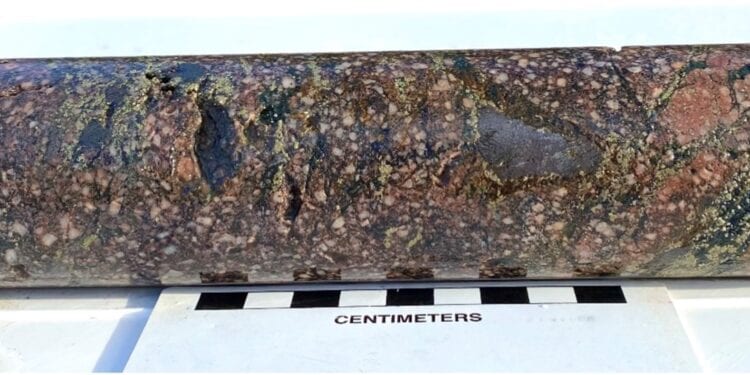Visible Gold Observed In Core
Lefroy Exploration Limited (ASX: LEX) has completed three more holes in its current 3000m diamond drilling programme evaluating the Burns copper (Cu) gold (Au) prospect in Western Australia.
Burns is within the Eastern Lefroy tenement package, which is part of the wholly owned greater Lefroy Gold Project (LGP) located 50km southeast of Kalgoorlie.
The Burns copper-gold prospect is situated on the eastern margin of a large interpreted felsic intrusion, termed the Burns Intrusion. The intrusion does not outcrop but features a distinctive annular aeromagnetic and gravity geophysical signature.
Broad high-grade gold mineralisation is hosted within a newly discovered hematite-pyrite-chalcopyrite-magnetite altered diorite porphyry that intrudes high Mg basalt. This porphyry, termed the Eastern Porphyry, is open to the north and south. The eastern extent of the Eastern Porphyry is now defined, on the zero north section at least, by foliated basalt. The mineralisation is open at depth.
The copper and gold mineralisation hosted by both the diorite porphyry and basalt is considered by the company to be a new style of mineralisation in the area, a land position dominated by Lefroy.
The existence of additional mineralisation further east under Lake Randall is not discounted by the current drilling campaign and will be the subject of more exploration and drilling in the future.
The 14-hole diamond drill programme commenced on 20 April 2021 to evaluate the Eastern Porphyry over a 200m strike length on 40m spaced drill sections.
Hole LEFRD267 intersected a 246m interval of the Eastern Porphyry from 244m downhole. The interval included multiple intervals of basalt up to 25m in length, some of which were deformed (foliated), carbonate veined and contained sulphides (pyrite). This was the broadest downhole interval of the Eastern Porphyry intersected at Burns, and although intervals of basalt were included, it suggested that the porphyry body is becoming wider with depth.
Recent sampling of the drill core from LEFRD267 revealed a speck of visual gold (VG) within calcite hosted by a sulphide bearing gypsum vein. The vein is hosted in basalt.
The observation of free gold associated with sulphides (chalcopyrite) in the gypsum vein now highlights the basalt as an additional host rock to both gold and copper mineralisation. More importantly the gold bound within the pink calcite within the gypsum vein provides important implications for the timing of the gold mineralisation. The presence of the pink calcite veins may indicate an association with the gold and or copper mineralising event.
A further two holes have now been completed on the zero-north section to finalise the initial five- hole diamond drilling campaign along this key section. The geometry and alteration character of the Eastern Porphyry on the zero north will provide a useful calibration to understand the geology on adjacent step out sections.
Hole LEFRD268 was extended from 330.8m to a final depth of 582.8m, which is the deepest hole drilled to date by the company at Burns. The hole intersected some broad zones of disseminated pyrite mineralisation associated with weak fracturing and haematite alteration in the Eastern Porphyry and calcite veining within basalt.
The final hole LEFRD282 was wedged off the RC pre-collar at 51.6m and extended to a depth of 270.8m. This was the Eastern most hole on the zero north section. It confirms the steep geometry and approximate 120m width of the Eastern Porphyry near surface.
The completion of the five diamond holes on the zero north section has now established at least 180m of vertical depth continuity of altered and mineralised porphyry below the 37m zone of Au/Cu mineralisation in LEFR 260 (38m @ 7.63g/t Au & 0.56% Cu from 134m).
The mineralisation remains open below this level. The drill data has also defined the boundaries to the Eastern Porphyry body which has approximate 120m true width.
An estimated 3000m of diamond drilling is planned in this diamond drill programme that commenced in late April. Drilling continues to be undertaken using one drill rig on a single shift, but preparations are in place to commence double shift to accelerate the programme.
The 14-hole programme is live and allows for flexibility to adjust or add holes, hole depths and priority dependent on the geology intersected in completed holes. The position of the Eastern Porphyry also gives scope for the company to utilise older (2011-2015) RC holes as pre collars.
For further information please visit: https://lefroyex.com/












